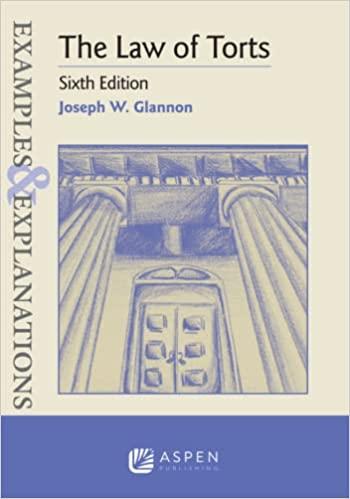Question
CASE # 2 - I'm a Lumberjack and I'm OK. Jack owned and operated one of a multitude of small logging operations in Western Canada
CASE # 2 - I'm a Lumberjack and I'm OK. Jack owned and operated one of a multitude of small logging operations in Western Canada called Lumberjack Inc. A few of these small operators had their own allocations of timber (as licensed by the provincial government) but most including Jack, were "contractors" working for larger companies (the Majors). This meant that for a negotiated contract price they would go onto the areas licensed to the major company and harvest that timber for them. They also occasionally harvested timber for private landowners who had stands of timber on their own land. They would contract to purchase the standing timber, cut these logs and sell them to one of the major companies to be made into pulp or sawed and sorted for lumber depending on the type of timber and the quality and size of log. There were only a few of these major companies and the small loggers usually had no choice but to sell their logs to the one operating nearest to them because of the prohibitive cost of transporting the Logs.
Jack has another significant problem that he has to deal with as well. In one of his deals, he agreed to log a stand of timber covering 1/3 of Sam's ranch. This was a nice property located on the wall of a small valley near a lake which Sam intended to convert into a guest ranch in the near future although he never told this to Jack. The ranch covered 150 acres and was worth on the open market about $200,000. This was a little higher than normal because of the nice location of the ranch. In fact, this is what Sam had paid for the property 6 months earlier. One of the reason's Sam bought the ranch was because he knew he could sell the timber. Sam's deal with Jack required Jack to pay Sam $100,000 for the standing timber. Jack then would come onto the property with his men and equipment and remove the trees "with as little disruption to the rest of the property as possible." In addition to this provision included in the contract the agreement also required that after the trees were harvested the property be "restored" within 2 years of the harvest.
One of the workers cut down the trees in June 1993 using clear cut methods and Jack resold the timber for $200,000 which after considering his costs left a profit to the company of $25,000. Unfortunately, the property was left in a very disreputable condition. Roads had been made crossing other parts of the ranch, stream beds were destroyed in the process and the clear cutting itself left that part of the property in a miserable mess with the land not only dug up by the equipment used but covered with all sorts of unsightly debris. No attempt was made by Jack's company to "restore" the property after the removal of the trees. Jack explained to Sam that there was "just not enough money in it." Sam had expected this part of the ranch to be cleared and then to be landscaped giving a dramatic view of the valley and lake making it ideal for use as a guest ranch. Instead, he was left with a blasted landscape looking as bad as any clear cut extending beyond the original tree stand and making it impossible to develop the property as he intended. When Sam inquired, he discovered that it would cost him $150,000 to clean up the property and put it into the shape that he had envisioned when he started the project
Sam complained to Jack and threatened to sue. He demanded that the property be restored as agreed or that he receive compensation so that he could have the work done by someone else. Jack was surprised when Sam told him he intended to develop the property as a guest ranch. Jack had assumed he would be using it as a cattle ranch like all of the others in the areas and that the esthetic value of the property was "no big deal." He investigated and found that if the property were used as a cattle ranch as he thought it would be the increased market value had it been landscaped as Sam wanted would only go from $200,000 to $215,000.
One the other hand if the property were developed as a guest ranch the restoration and landscaping would be a vital part of the project and would have increased the value dramatically.
Case Study: Explain the legal position of the parties in these situations and explain what should be done by them. Use appropriate sections of the textbook in your discussion. Do only the part of this case that discusses Jack's contract with Sam and the clearing of his land. Ignore the information about the 'pricing' which I have left in the case but have greyed out (so you can still read it for more information, but it's probably not relevant to the case).
Step by Step Solution
There are 3 Steps involved in it
Step: 1

Get Instant Access to Expert-Tailored Solutions
See step-by-step solutions with expert insights and AI powered tools for academic success
Step: 2

Step: 3

Ace Your Homework with AI
Get the answers you need in no time with our AI-driven, step-by-step assistance
Get Started


